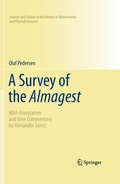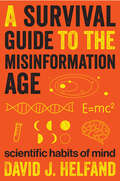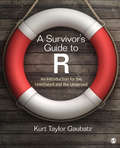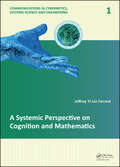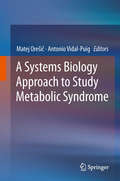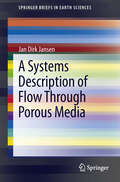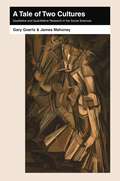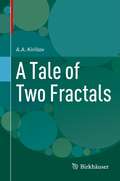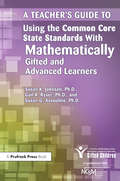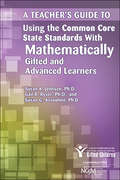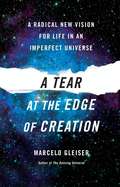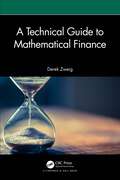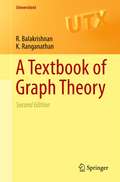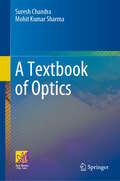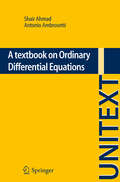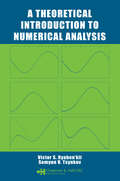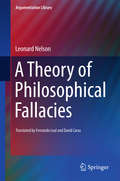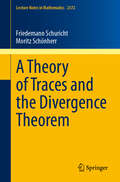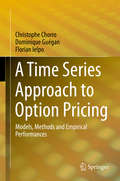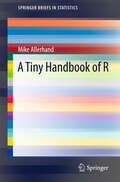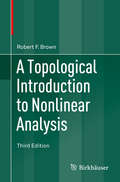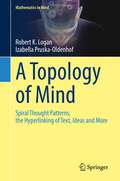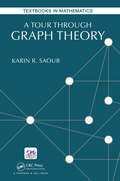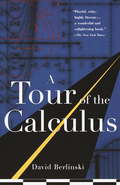- Table View
- List View
A Survey of the Almagest: With Annotation and New Commentary by Alexander Jones (Sources and Studies in the History of Mathematics and Physical Sciences)
by Alexander Jones Olaf PedersenThe Almagest, by the Greek astronomer and mathematician Ptolemy, is the most important surviving treatise on early mathematical astronomy, offering historians valuable insight into the astronomy and mathematics of the ancient world. Pedersen's 1974 publication, A Survey of the Almagest, is the most recent in a long tradition of companions to the Almagest. Part paraphrase and part commentary, Pedersen's work has earned the universal praise of historians and serves as the definitive introductory text for students interested in studying the Almagest. In this revised edition, Alexander Jones, a distinguished authority on the history of early astronomy, provides supplementary information and commentary to the original text to account for scholarship that has appeared since 1974. This revision also incorporates various corrections to Pedersen's original text that have been identified since its publication. This volume is intended to provide students of the history of astronomy with a self-contained introduction to the Almagest, helping them to understand and appreciate Ptolemy's great and classical work.
A Survival Guide to the Misinformation Age: Scientific Habits of Mind
by David HelfandWe live in the Information Age, with billions of bytes of data just two swipes away. Yet how much of this is mis- or even disinformation? A lot of it is, and your search engine can't tell the difference. As a result, an avalanche of misinformation threatens to overwhelm the discourse we so desperately need to address complex social problems such as climate change, the food and water crises, biodiversity collapse, and emerging threats to public health. This book provides an inoculation against the misinformation epidemic by cultivating scientific habits of mind. Anyone can do it—indeed, everyone must do it if our species is to survive on this crowded and finite planet.This survival guide supplies an essential set of apps for the prefrontal cortex while making science both accessible and entertaining. It will dissolve your fear of numbers, demystify graphs, and elucidate the key concepts of probability, all while celebrating the precise use of language and logic. David Helfand, one of our nation's leading astronomers and science educators, has taught scientific habits of mind to generations in the classroom, where he continues to wage a provocative battle against sloppy thinking and the encroachment of misinformation.
A Survivor's Guide to R: An Introduction for the Uninitiated and the Unnerved
by Kurt Taylor GaubatzFocusing on developing practical R skills rather than teaching pure statistics, Dr. Kurt Taylor Gaubatz’s A Survivor’s Guide to R provides a gentle yet thorough introduction to R. The book is structured around critical R tasks, and focuses on applied knowledge, rather than abstract concepts. Gaubatz’s easy-to-read approach helps students with little or no background in statistics or programming to develop real-world R skills through straightforward coverage of R objects and functions. Focusing on real-world data, the challenges of dataset construction, and the use of R’s powerful graphing tools, the guide is written in an accessible, sympathetic, even humorous style that ensures students acquire functional R skills they can use in their own projects and carry into their work beyond the classroom.
A Systemic Perspective on Cognition and Mathematics (Communications in Cybernetics, Systems Science and Engineering)
by Jeffrey Yi-Lin ForrestThis book is devoted to the study of human thought, its systemic structure, and the historical development of mathematics both as a product of thought and as a fascinating case analysis. After demonstrating that systems research constitutes the second dimension of modern science, the monograph discusses the yoyo model, a recent ground-breaking deve
A Systems Biology Approach to Study Metabolic Syndrome
by Matej Orešič Antonio Vidal-PuigThe aim of this book is to provide the target audience, specifically students of Medicine, Biology, Systems Biology and Bioinformatics, as well as experienced researchers in research fields relevant to metabolic syndrome (MetS) with an overview of the challenges and opportunities in systems biology and how it can be used to tackle MetS. In particular, the aims are: (1) to provide an introduction to the key biological processes involved in the pathophysiology of MetS; (2) through the use of specific examples, provide an introduction to the latest technologies that use a systems biology approach to study MetS; and (3) to give an overview of the mathematical modeling approaches for studying MetS. The clearly written chapters by leading experts in the field provides detailed descriptions crucial for the unique position of this book and its focus on the application of systems biology to tackle specific pathophysiologically relevant aspects of MetS and provides a valuable practical guide to this research community.
A Systems Description of Flow Through Porous Media (SpringerBriefs in Earth Sciences)
by Jan Dirk JansenThis text forms part of material taught during a course in advanced reservoir simulation at Delft University of Technology over the past 10 years. The contents have also been presented at various short courses for industrial and academic researchers interested in background knowledge needed to perform research in the area of closed-loop reservoir management, also known as smart fields, related to e.g. model-based production optimization, data assimilation (or history matching), model reduction, or upscaling techniques. Each of these topics has connections to system-theoretical concepts. The introductory part of the course, i.e. the systems description of flow through porous media, forms the topic of this brief monograph. The main objective is to present the classic reservoir simulation equations in a notation that facilitates the use of concepts from the systems-and-control literature. Although the theory is limited to the relatively simple situation of horizontal two-phase (oil-water) flow, it covers several typical aspects of porous-media flow. The first chapter gives a brief review of the basic equations to represent single-phase and two-phase flow. It discusses the governing partial-differential equations, their physical interpretation, spatial discretization with finite differences, and the treatment of wells. It contains well-known theory and is primarily meant to form a basis for the next chapter where the equations will be reformulated in terms of systems-and-control notation.The second chapter develops representations in state-space notation of the porous-media flow equations. The systematic use of matrix partitioning to describe the different types of inputs leads to a description in terms of nonlinear ordinary-differential and algebraic equations with (state-dependent) system, input, output and direct-throughput matrices. Other topics include generalized state-space representations, linearization, elimination of prescribed pressures, the tracing of stream lines, lift tables, computational aspects, and the derivation of an energy balance for porous-media flow. The third chapter first treats the analytical solution of linear systems of ordinary differential equations for single-phase flow. Next it moves on to the numerical solution of the two-phase flow equations, covering various aspects like implicit, explicit or mixed (IMPES) time discretizations and associated stability issues, Newton-Raphson iteration, streamline simulation, automatic time-stepping, and other computational aspects. The chapter concludes with simple numerical examples to illustrate these and other aspects such as mobility effects, well-constraint switching, time-stepping statistics, and system-energy accounting. The contents of this brief should be of value to students and researchers interested in the application of systems-and-control concepts to oil and gas reservoir simulation and other applications of subsurface flow simulation such as CO2 storage, geothermal energy, or groundwater remediation.
A Tale of Two Cultures: Qualitative and Quantitative Research in the Social Sciences
by James Mahoney Gary GoertzSome in the social sciences argue that the same logic applies to both qualitative and quantitative methods. In A Tale of Two Cultures, Gary Goertz and James Mahoney demonstrate that these two paradigms constitute different cultures, each internally coherent yet marked by contrasting norms, practices, and toolkits. They identify and discuss major differences between these two traditions that touch nearly every aspect of social science research, including design, goals, causal effects and models, concepts and measurement, data analysis, and case selection. Although focused on the differences between qualitative and quantitative research, Goertz and Mahoney also seek to promote toleration, exchange, and learning by enabling scholars to think beyond their own culture and see an alternative scientific worldview. This book is written in an easily accessible style and features a host of real-world examples to illustrate methodological points.
A Tale of Two Fractals
by A. A. KirillovSince Benoit Mandelbrot's pioneering work in the late 1970s, scores of research articles and books have been published on the topic of fractals. Despite the volume of literature in the field, the general level of theoretical understanding has remained low; most work is aimed either at too mainstream an audience to achieve any depth or at too specialized a community to achieve widespread use. Written by celebrated mathematician and educator A.A. Kirillov, A Tale of Two Fractals is intended to help bridge this gap, providing an original treatment of fractals that is at once accessible to beginners and sufficiently rigorous for serious mathematicians. The work is designed to give young, non-specialist mathematicians a solid foundation in the theory of fractals, and, in the process, to equip them with exposure to a variety of geometric, analytical, and algebraic tools with applications across other areas.
A Teacher's Guide to Using the Common Core State Standards With Mathematically Gifted and Advanced Learners
by Susan Assouline National Assoc For Gifted Children Gail R. RyserA Teacher's Guide to Using the Common Core State Standards in Mathematics provides teachers and administrators with practical examples of ways to build a comprehensive, coherent, and continuous set of learning experiences for gifted and advanced students. It describes informal, traditional, off-level, and 21st century math assessments that are useful in making educational decisions about placement and programming. Featuring learning experiences for each grade within one math progression, the book offers insight into useful ways of both accelerating and enriching the CCSS mathematics standards. Each of the learning experiences includes a sequence of activities, implementation examples, and formative assessments. Specific instructional and management strategies for implementing the standards within the classroom, school, and school district will be helpful for both K-12 teachers and administrators.
A Teacher's Guide to Using the Common Core State Standards with Mathematically Gifted and Advanced Learners
by Gail Ryser Susan Assouline Susan JohnsenA Teacher's Guide to Using the Common Core State Standards With Mathematically Gifted and Advanced Learners provides teachers and administrators with practical examples of ways to build a comprehensive, coherent, and continuous set of learning experiences for gifted and advanced students. It describes informal, traditional, off-level, and 21st century math assessments that are useful in making educational decisions about placement and programming. Featuring learning experiences for each grade within one math progression, the book offers insight into useful ways of both accelerating and enriching the CCSS mathematics standards. Each of the learning experiences includes a sequence of activities, implementation examples, and formative assessments. Specific instructional and management strategies for implementing the standards within the classroom, school, and school district will be helpful for both K-12 teachers and administrators.
A Tear at the Edge of Creation: A Radical New Vision for Life in an Imperfect Universe
by Marcelo GleiserFor millennia, shamans and philosophers, believers and nonbelievers, artists and scientists have tried to make sense of our existence by suggesting that everything is connected, that a mysterious Oneness binds us to everything else. People go to temples, churches, mosques, and synagogues to pray to their divine incarnation of Oneness. Following a surprisingly similar notion, scientists have long asserted that under Nature's apparent complexity there is a simpler underlying reality. In its modern incarnation, this Theory of Everything would unite the physical laws governing very large bodies (Einstein's theory of relativity) and those governing tiny ones (quantum mechanics) into a single framework. But despite the brave efforts of many powerful minds, the Theory of Everything remains elusive. It turns out that the universe is not elegant. It is gloriously messy. Overturning more than twenty-five centuries of scientific thought, award-winning physicist Marcelo Gleiser argues that this quest for a Theory of Everything is fundamentally misguided, and he explains the volcanic implications this ideological shift has for humankind. All the evidence points to a scenario in which everything emerges from fundamental imperfections, primordial asymmetries in matter and time, cataclysmic accidents in Earth's early life, and duplication errors in the genetic code. Imbalance spurs creation. Without asymmetries and imperfections, the universe would be filled with nothing but smooth radiation. A Tear at the Edge of Creation calls for nothing less than a new "humancentrism" to reflect our position in the universal order. All life, but intelligent life in particular, is a rare and precious accident. Our presence here has no meaning outside of itself, but it does have meaning. The unplanned complexity of humankind is all the more beautiful for its improbability. It's time for science to let go of the old aesthetic that labels perfection beautiful and holds that "beauty is truth. " It's time to look at the evidence without centuries of monotheistic baggage. In this lucid, down-to-earth narrative, Gleiser walks us through the basic and cutting-edge science that fueled his own transformation from unifier to doubter--a fascinating scientific quest that led him to a new understanding of what it is to be human.
A Technical Guide to Mathematical Finance (Chapman and Hall/CRC Financial Mathematics Series)
by Derek ZweigA Technical Guide to Mathematical Finance covers those foundational mathematical topics most important to an aspiring or professional quant. The text goes beyond a simple recitation of methods and aims to impart a genuine understanding of the fundamental concepts underpinning most of the techniques and tools routinely used by those working in quantitative finance.Features Suitable for professional quants and graduate students in finance, and mathematical/quantitative finance “Concept Refreshers” used throughout to provide pithy summaries of complex topics Step-by-step detail for formal proofs and mathematical descriptions
A TextBook of Cost and Management Accounting 10 Edition - PART-I
by M. N. AroraThis book provides the students with thorough grounding in cost concepts, cost behaviour and methods, and techniques of cost and management accounting with an understanding of the uses and limitations of cost and financial data for managerial operations. The text of the subject matter has been presented in a student-friendly, simple and intelligible manner. Every discussion involving conceptual complexity is immediately illustrated by a numerical example. In addition, the book contains a liberal sprinkling of charts and diagrams so as to make the subject easily understandable and highlight its finer points. The subject matter has been organized on â first things firstâ basis for its logical presentation that sustains interest. The approach of the book is examination oriented. Thus, a good number of problems and solutions have been included in its chapters. Theoretical and numerical questions have been mostly selected from various examinations. Objective type questions have been given to serve as self test by students. This is an ideal book for self study.
A Textbook of Graph Theory (Universitext)
by K. Ranganathan R. BalakrishnanGraph theory experienced a tremendous growth in the 20th century. One of the main reasons for this phenomenon is the applicability of graph theory in other disciplines such as physics, chemistry, psychology, sociology, and theoretical computer science. This textbook provides a solid background in the basic topics of graph theory, and is intended for an advanced undergraduate or beginning graduate course in graph theory. This second edition includes two new chapters: one on domination in graphs and the other on the spectral properties of graphs, the latter including a discussion on graph energy. The chapter on graph colorings has been enlarged, covering additional topics such as homomorphisms and colorings and the uniqueness of the Mycielskian up to isomorphism. This book also introduces several interesting topics such as Dirac's theorem on k-connected graphs, Harary-Nashwilliam's theorem on the hamiltonicity of line graphs, Toida-McKee's characterization of Eulerian graphs, the Tutte matrix of a graph, Fournier's proof of Kuratowski's theorem on planar graphs, the proof of the nonhamiltonicity of the Tutte graph on 46 vertices, and a concrete application of triangulated graphs.
A Textbook of Optics
by Suresh Chandra Mohit Kumar SharmaThis book is designed to serve as a textbook for courses offered to upper-undergraduate students enrolled in physics and explains the broad spectrum of optics in a student-friendly way. The textbook covers the entire syllabi of the undergraduate courses being taught at both national and international universities including adequate details of mathematical expressions to help students understand the subject matter. The topics covered in this book are reflection, refraction, cardinal points, interference, Fresnel diffraction, Fraunhofer diffraction, lasers and holography, fiber optics, etc. This book explains each topic in a simple and lucid language with the help of solved problems. Exercises with multiple choice questions have been given at the end of each chapter for self-assessment. The detailed coverage and pedagogical tools make this an ideal textbook for students and researchers enrolled in senior undergraduate and beginning postgraduate physics students.
A Textbook on Ordinary Differential Equations (UNITEXT #73)
by Shair Ahmad Antonio AmbrosettiThe book is a primer of the theory of Ordinary Differential Equations. Each chapter is completed by a broad set of exercises; the reader will also find a set of solutions of selected exercises. The book contains many interesting examples as well (like the equations for the electric circuits, the pendulum equation, the logistic equation, the Lotka-Volterra system, and many other) which introduce the reader to some interesting aspects of the theory and its applications. The work is mainly addressed to students of Mathematics, Physics, Engineering, Statistics, Computer Sciences, with knowledge of Calculus and Linear Algebra, and contains more advanced topics for further developments, such as Laplace transform; Stability theory and existence of solutions to Boundary Value problems. A complete Solutions Manual, containing solutions to all the exercises published in the book, is available. Instructors who wish to adopt the book may request the manual by writing directly to one of the authors.
A Theoretical Introduction to Numerical Analysis
by Victor S. Ryaben'kii Semyon V. TsynkovA Theoretical Introduction to Numerical Analysis presents the general methodology and principles of numerical analysis, illustrating these concepts using numerical methods from real analysis, linear algebra, and differential equations. The book focuses on how to efficiently represent mathematical models for computer-based study. An access
A Theory of Philosophical Fallacies (Argumentation Library #26)
by Leonard NelsonPresented as a Vorlesung in the German philosophical tradition, this book presents the most detailed account of Nelson's method of argument analysis, celebrated by many luminaries such as Karl Popper. It was written in 1921 in opposition to the relativistic, subjectivistic and nihilistic tendencies of Nelson's time. The book contains an exposition of a method that is a further development of Kant's transcendental dialectics, followed by an application to the critical analysis of arguments by many famous thinkers, including Bentham, Mill, Poincaré, Leibniz, Hegel, Einstein, Bergson, Rickert, Simmel, Brentano, Stammler, Jellinek, Dingler, and Meinong. The book presents a general theory of philosophical argumentation as seen from the viewpoint of the typical fallacies committed by anybody arguing philosophically, whether professional philosophers or philosophical laypeople. Although the nature of philosophy and philosophical argumentation is one of the most recurrent objects of reflection for philosophers, this book represents the first attempt at a general theory of philosophical fallacy. According to Nelson, it is in the shape of false dilemmas that errors in reasoning always emerge, and false dilemmas are always the result of the same mechanism--the unwitting replacement of one concept for another.
A Theory of Traces and the Divergence Theorem (Lecture Notes in Mathematics #2372)
by Friedemann Schuricht Moritz SchönherrThis book provides a new approach to traces, which are viewed as linear continuous functionals on some function space. A key role in the analysis is played by integrals related to finitely additive measures, which have not previously been considered in the literature. This leads to Gauss-Green formulas on arbitrary Borel sets for vector fields having divergence measure as well as for Sobolev and BV functions. The integrals used do not require trace functions or normal fields on the boundary and they can deal with inner boundaries. For the treatment of apparently intractable degenerate cases a second boundary integral is used. The calculus developed here also allows integral representations for the precise representative of an integrable function and for the usual boundary trace of Sobolev or BV functions. The theory presented gives a new perspective on traces for beginners as well as experts interested in partial differential equations. The integral calculus might also be a stimulating tool for geometric measure theory.
A Time Series Approach to Option Pricing: Models, Methods and Empirical Performances
by Florian Ielpo Christophe Chorro Dominique GuéganThe current world financial scene indicates at an intertwined and interdependent relationship between financial market activity and economic health. This book explains how the economic messages delivered by the dynamic evolution of financial asset returns are strongly related to option prices. The Black Scholes framework is introduced and by underlining its shortcomings, an alternative approach is presented that has emerged over the past ten years of academic research, an approach that is much more grounded on a realistic statistical analysis of data rather than on ad hoc tractable continuous time option pricing models. The reader then learns what it takes to understand and implement these option pricing models based on time series analysis in a self-contained way. The discussion covers modeling choices available to the quantitative analyst, as well as the tools to decide upon a particular model based on the historical datasets of financial returns. The reader is then guided into numerical deduction of option prices from these models and illustrations with real examples are used to reflect the accuracy of the approach using datasets of options on equity indices.
A Tiny Handbook of R (SpringerBriefs in Statistics)
by Mike AllerhandThis Brief provides a roadmap for the R language and programming environment with signposts to further resources and documentation.
A Topological Introduction to Nonlinear Analysis
by Robert F. BrownThis third edition is addressed to the mathematician or graduate student of mathematics - or even the well-prepared undergraduate - who would like, with a minimum of background and preparation, to understand some of the beautiful results at the heart of nonlinear analysis. Based on carefully-expounded ideas from several branches of topology, and illustrated by a wealth of figures that attest to the geometric nature of the exposition, the book will be of immense help in providing its readers with an understanding of the mathematics of the nonlinear phenomena that characterize our real world. Included in this new edition are several new chapters that present the fixed point index and its applications. The exposition and mathematical content is improved throughout. This book is ideal for self-study for mathematicians and students interested in such areas of geometric and algebraic topology, functional analysis, differential equations, and applied mathematics. It is a sharply focused and highly readable view of nonlinear analysis by a practicing topologist who has seen a clear path to understanding. "For the topology-minded reader, the book indeed has a lot to offer: written in a very personal, eloquent and instructive style it makes one of the highlights of nonlinear analysis accessible to a wide audience. "-Monatshefte fur Mathematik (2006)
A Topology of Mind: Spiral Thought Patterns, the Hyperlinking of Text, Ideas and More (Mathematics in Mind)
by Robert K. Logan Izabella Pruska-OldenhofThis volume covers many diverse topics related in varying degrees to mathematics in mind including the mathematical and topological structures of thought and communication. It examines mathematics in mind from the perspective of the spiral, cyclic and hyperlinked structures of the human mind in terms of its language, its thoughts and its various modes of communication in science, philosophy, literature and the arts including a chapter devoted to the spiral structure of the thought of Marshall McLuhan. In it, the authors examine the topological structures of hypertext, hyperlinking, and hypermedia made possible by the Internet and the hyperlinked structures that existed before its emergence. It also explores the cognitive origins of mathematical thinking of the human mind and its relation to the emergence of spoken language, and studies the emergence of mathematical notation and its impact on education. Topics addressed include:• The historical context of any topic that involves how mathematical thinking emerged, focusing on archaeological and philological evidence. • Connection between math cognition and symbolism, annotation and other semiotic processes. • Interrelationships between mathematical discovery and cultural processes, including technological systems that guide the thrust of cognitive and social evolution. • Whether mathematics is an innate faculty or forged in cultural-historical context• What, if any, structures are shared between mathematics and language
A Tour Through Graph Theory (Textbooks in Mathematics)
by Karin R Saoub<p>A Tour Through Graph Theory introduces graph theory to students who are not mathematics majors. Rather than featuring formal mathematical proofs, the book focuses on explanations and logical reasoning. It also includes thoughtful discussions of historical problems and modern questions. The book inspires readers to learn by working through examples, drawing graphs and exploring concepts. <p>This book distinguishes itself from others covering the same topic. It strikes a balance of focusing on accessible problems for non-mathematical students while providing enough material for a semester-long course.</p>
A Tour of the Calculus
by David BerlinskiIn its largest aspect, the calculus functions as a celestial measuring tape, able to order the infinite expanse of the universe. Time and space are given names, points, and limits; seemingly intractable problems of motion, growth, and form are reduced to answerable questions. Calculus was humanity's first attempt to represent the world and perhaps its greatest meditation on the theme of continuity. Charts and graphs throughout.From the Hardcover edition.
